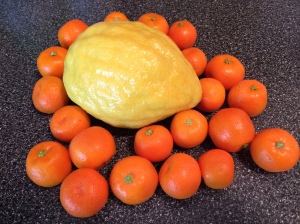way back in january, i was fortunate enough to get an etrog and a bag of calamondin fruit.  calamondin is a small citrus fruit that resembles an orange, but it’s about the size of a kumquat.
calamondin is a small citrus fruit that resembles an orange, but it’s about the size of a kumquat.
calamondin smell sweet but have a sour taste. at first, i thought i might make some marmalade with it but cooler heads prevailed and i set my sights on making a liqueur similar to limoncello, that i could use as a cooking extract or in cocktails. making the liqueur is super quick and easy and once jarred only needs turning the jar over once a day for as long as you age it. all you need to make it, besides the fruit, is a clear spirit like vodka and some sugar.
 i left mine to age for nearly 3 months and was rewarded with syrupy goodness and a ton of new cocktails to make.
i left mine to age for nearly 3 months and was rewarded with syrupy goodness and a ton of new cocktails to make.  what’s great about making a liqueur with a citrus fruit is that after straining the liqueur you are also left with wonderful preserved fruit that can be used in cooking as garnish in drinks or shredded over desserts. my mom took all the leftover preserved calamondin halves with plans to shred them as garnish for ice cream and cakes.
what’s great about making a liqueur with a citrus fruit is that after straining the liqueur you are also left with wonderful preserved fruit that can be used in cooking as garnish in drinks or shredded over desserts. my mom took all the leftover preserved calamondin halves with plans to shred them as garnish for ice cream and cakes. 
Calamondin Liqueur
Ingredients
30 calamondin fruit
2 1/2 cups vodka (I used Absolut)
600 g (3 cups) granulated cane sugar
Method
Wash the calamondin, cut them in half and if there are seeds, remove them. Pour vodka and sugar in 2-quart jar with a tight lid. Shake or stir thoroughly to dissolve sugar. Add the calamondin halves to the jar and cover tightly. Set in a cool dry place like a dark corner of your kitchen counter.
Each day for at least 60 days, invert jar. One day, turn right side up; the next day, turn upside down. After 60 or so days, strain; pour the strained liqueur in bottle with top; store in a cool dry place or refrigerate. Use the preserved fruit for garnish or cooking




I can’t wait to try this because I have a Calamondin tree–the nursery where I bought it, said it was a type of lemon tree (makes some great gluten-free lemon cookies).
LikeLike
ooh a whole tree! i’m so envious. please let me know how it comes out. in an upcoming post, you’ll get to see what else i was able to make using the liqueur. Gaye, can you share your lemon cookie recipe? pretty please?
LikeLike
Calamondins anyone? I have 3 trees. Best fruit I ever had!!!!
LikeLike
I have 3 trees. Calamondins are the best ever!!!
LikeLike
I made the calamondin liqueur and strained it several times through a coffee filter but even there is always some deposits that cumulate at the bottom of the bottle, is it supposed to be?
LikeLike
Kim, thanks for your question. It’s fine. Honestly, I’ve never been able to avoid having a small amount of deposit in the bottom. Think of it as extra flavor. -L
LikeLike
you can also decant the clear liqueur carefully from one container to a new bottle, leaving the cloudy stuff on the bottom for “perfect” clarity.
Do you have an opinion about making this recipe using my non-setting calamondin marmalade. I have one batch [three pints] that I have tried three times to set and am giving up. Subsequent batches set perfectly.
We have 1 tree that produces over 400 calamondins each year.
LikeLike
Les, Thanks for your comment, decanting is a terrific solution.
I don’t know if it would be safe to use the unset marmalade to make liqueur but I guess it’s really just a chunky simple syrup. I think the unset marmalade could be great as a flavoring in cocktails.
I think I have tree envy, that’s a lot of calamondin!
LikeLike
You really thought this recipe through. Thank you so much. I made a double batch last year and to the letter of this recipe. It’s perfect. Silky, buttery, intense orange with the tiniest bitter to it.
This year, my two little Calamondin trees put out around five pounds and I made another double batch, but added a very few extra fruits, a little extra sugar and vodka. I think it will still be fine.
I still have my boozy leftover fruits from my last batch in the freezer. They make amazing gin and tonics. And considering using them for dark fruitcake.
LikeLike
Thanks so much for your comment. I’m so glad you had success with the recipe. Cheers!
LikeLike
Pingback: To Gift or Not to Gift: Burning the Binary of Holiday Giving - Blue Venus Rising
Can you use Tequila instead?
LikeLike
what a great idea! i don’t see why it wouldn’t work. maybe taste every few days to see when it tastes just right.
LikeLike